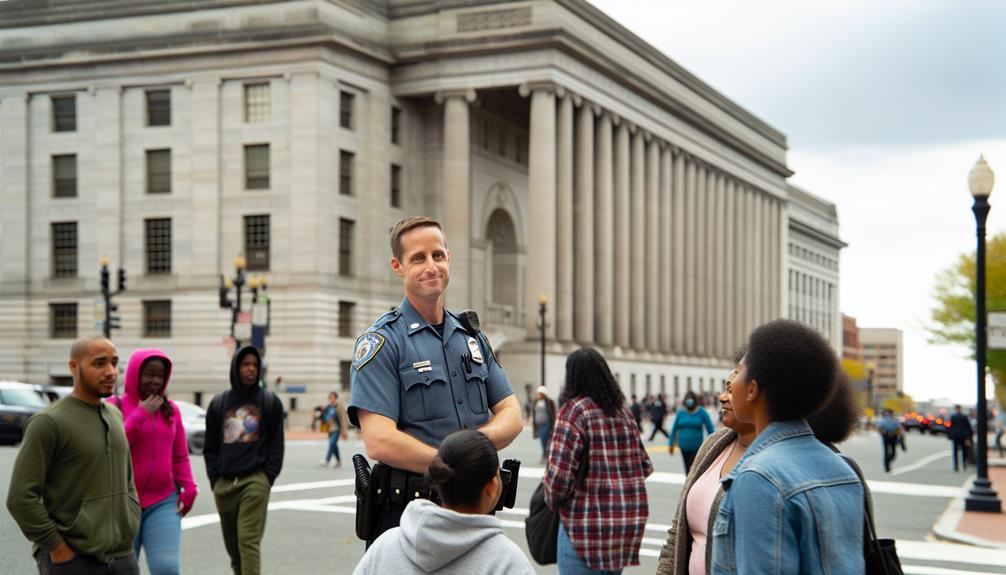The legacy of carriages in transportation history is profound, marking significant advancements in mobility and societal structures. Evolving from simple sleds to ornate designs, carriages facilitated trade and social interactions while reflecting status and identity. They transformed urban landscapes in the 18th and 19th centuries, prompting infrastructural adaptations and social mobility. Additionally, craftsmanship and design innovations laid the groundwork for modern vehicles. The decline of carriages with the advent of motorized transport illustrates broader societal shifts towards efficiency. This intricate relationship between carriages and transportation underpins many of today's mobility principles, revealing a rich tapestry worth further exploration.
Key Takeaways
- Carriages evolved transportation from rudimentary methods to sophisticated systems, enhancing trade, social interactions, and accessibility.
- Diverse carriage types reflect cultural significance, showcasing social status and regional identities through unique designs and practical adaptations.
- Ownership of carriages marked social status and influenced gender roles, facilitating mobility and participation in community events.
- Innovations in carriage design, such as improved suspension and lightweight materials, laid the groundwork for modern vehicle advancements.
- The transition from horse-drawn carriages to motorized vehicles symbolized broader societal shifts towards mechanization, efficiency, and urban development.
The Evolution of Carriages
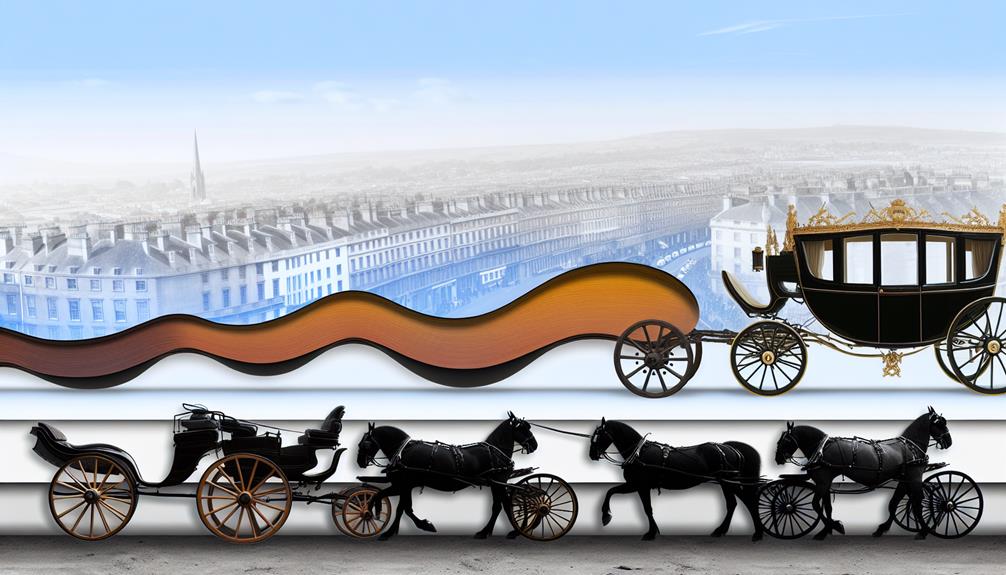
Throughout history, carriages have consistently played a pivotal role in the evolution of transportation, reflecting broader social and technological trends. The horse-drawn evolution marked a significant shift from rudimentary forms of travel to more sophisticated means, enabling greater mobility for individuals and goods alike. In the early days, simple sleds and carts were utilized, but as societies advanced, so did carriage technology. The integration of advanced technologies in modern venues, like the Sphere in Las Vegas, showcases how innovation continues to push the boundaries of transportation and experience, highlighting a similar trajectory in both fields job opportunities at Sphere.
The introduction of improved axle designs, lightweight materials, and enhanced wheel construction allowed for smoother rides and increased durability. These innovations not only facilitated trade and commerce but also played an essential role in social interactions by making distant travel more accessible.
Carriages came to symbolize status and wealth, with ornate designs often reflecting the owner's social standing. As urban centers grew, the demand for efficient transportation solutions led to further refinements in carriage technology, fostering a culture where belonging and identity were intertwined with mobility.
Thus, the evolution of carriages is a representation of humanity's enduring quest for progress, illustrating how advancements in transportation have shaped societal structures and personal connections throughout history.
Types of Carriages
Carriages, in their diverse forms, have been integral to the development of transportation systems across various cultures and eras. The array of carriage types reflects historical uses that evolved to meet the needs of society, from horse-drawn variations suited for urban environments to those designed for rural transport. Luxury carriages, often elaborately adorned, exemplify the decorative styles favored by the elite, while functional designs prioritize practicality and durability. Understanding the historical context of care facilities like Fairview Nursing Care Center can provide insight into how transportation has evolved to serve various community needs.
Regional differences have greatly influenced carriage adaptations, as local materials, cultural aesthetics, and environmental factors shaped their construction. For instance, the lighter, more agile vehicles in mountainous areas differ markedly from the robust designs found in flat, expansive plains. Understanding these regional nuances offers insight into the interconnectedness of geography and transportation.
Carriage maintenance is essential to preserving these historical artifacts, ensuring that both their mechanical and aesthetic qualities are upheld. As we examine the diverse types of carriages, it becomes clear that they are not merely vehicles but rather reflections of societal values, technological advancements, and an enduring legacy that continues to resonate in modern transportation. Each carriage type tells a story, bridging the past with the present in the ongoing narrative of human mobility.
The Role of Carriages in Society
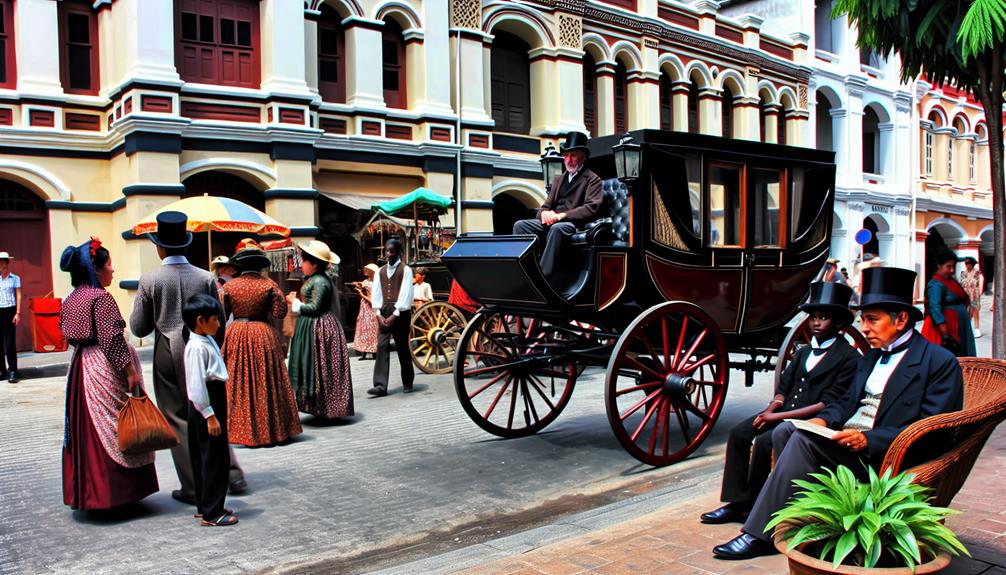
The diverse types of carriages discussed previously reveal their multifaceted roles within society, extending beyond mere transportation to encompass social, economic, and cultural dimensions. Historically, the ownership and use of carriages often signified social status, with lavish designs and materials marking their owners as affluent members of society. This visibility reinforced transportation norms that distinguished between classes, influencing leisure activities that were accessible only to the elite. In modern contexts, similar exclusivity can be observed in luxurious environments, such as the distinctive atmosphere of John Reed Gym in West Hollywood, where status is also reflected in the amenities offered.
Economically, carriages facilitated family mobility and rural accessibility, enabling families to engage in trade and commerce, thereby shaping local economies. Their presence in communal gatherings and ceremonial uses, such as weddings and parades, highlighted their significance in marking important societal events and fostering community bonds. Additionally, carriages played an essential role in historical events, serving both functional and symbolic purposes during times of change.
Gender roles were also influenced by carriage usage, as women often navigated societal expectations while participating in leisure and social activities, thereby redefining their public presence. Fundamentally, carriages were not merely vehicles but pivotal instruments that shaped the societal landscape, impacting everything from personal identity to community cohesion.
Carriages and Urban Development
A significant transformation in urban landscapes can be traced back to the proliferation of carriages during the 18th and 19th centuries, which fundamentally reshaped the design and functionality of cities. Carriages facilitated unprecedented social mobility, allowing diverse populations to traverse urban environments with greater ease. This newfound mobility spurred economic growth, as access to markets and employment opportunities expanded beyond immediate neighborhoods. Additionally, as cities adapted to the needs of carriage users, they began to implement more structured urban planning strategies, leading to a more organized allocation of resources and spaces for the community, similar to how mastering healthy meals emphasizes the importance of balance and structure in meal preparation.
The development of infrastructure, including designated carriage routes, became essential in accommodating this surge in transportation. Cities began to prioritize the creation of wider streets and improved road surfaces, which not only enhanced the efficiency of travel but also influenced the layout of urban spaces. Public spaces evolved as well, with parks and plazas designed to cater to the leisure activities of carriage users, fostering community engagement.
However, this transformation was not without its environmental impact. The increased presence of carriages contributed to urban pollution and congestion, prompting early discussions on sustainable urban planning. In this historical context, carriages served as both a catalyst for urban development and a symbol of the complexities inherent in the evolution of city life, reflecting the interplay between transportation and urban identity.
Craftsmanship and Design Innovations
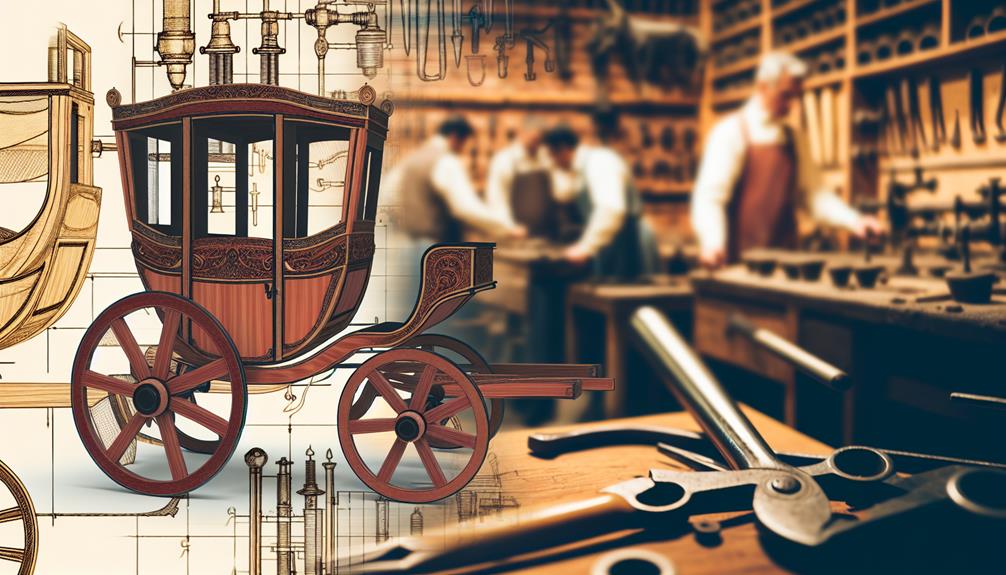
The craftsmanship and design innovations in carriage construction reflect a significant evolution in both artistry and functionality. Notable advancements in woodwork, particularly in the intricate detailing of carriage bodies, exemplify a blend of aesthetic appeal and structural integrity. Furthermore, just as in culinary practices where the right ingredients can elevate a dish, the careful selection of materials has influenced carriage design. For instance, the use of lightweight but strong woods mirrors the principles seen in Delicious Corn Flour Recipes that focus on quality ingredients for ideal results. Additionally, improvements in wheel design and suspension systems, alongside the adoption of new materials and techniques, have greatly enhanced the performance and durability of carriages throughout history.
Artistry in Woodwork
Craftsmanship in woodwork has played a pivotal role in the evolution of carriages, reflecting not only the technological advancements of each era but also the aesthetic sensibilities of their time. The intricate designs and ornate embellishments found in carriage construction illustrate a rich tradition of historical craftsmanship that intertwines functionality with artistic expression.
Traditional woodworking techniques have allowed artisans to create visually stunning pieces that serve practical purposes, exemplifying functional artistry at its finest. Decorative techniques, such as inlays and carvings, not only enhance the visual appeal of carriages but also signify the cultural heritage of the communities that produced them.
As we explore the artistry of wood craftsmanship, it becomes evident that each carriage embodies a unique narrative, merging the past with contemporary appreciation for heritage preservation. This legacy of craftsmanship invites enthusiasts and historians alike to connect with a shared history, fostering a sense of belonging to a time when artistry was paramount in transportation design. The enduring elegance of these wooden carriages serves as a reflection of the skill and creativity of past artisans, ensuring that their contributions remain celebrated in the annals of transportation history.
Wheel and Suspension Advances
As advancements in wheel and suspension technology emerged, they notably transformed the functionality and comfort of carriages, reflecting a keen understanding of both engineering principles and user experience. The evolution of wheel technology, including innovations such as the introduction of spokes and lightweight materials, facilitated smoother rides, reducing friction and enhancing durability. These improvements not only elevated the efficiency of carriage travel but also fostered a sense of reliability among users, who increasingly relied on these vehicles for both personal and commercial transport.
Furthermore, the development of sophisticated suspension systems played a pivotal role in this transformation. Early designs often utilized simple leather straps or springs, but as understanding deepened, more complex configurations emerged. The incorporation of multi-leaf springs and later, elliptical springs, considerably mitigated the impact of uneven terrain, allowing for a more stable and enjoyable journey. These enhancements underscored a commitment to craftsmanship that resonated with carriage users, providing a tangible connection between engineering innovation and everyday experience. The legacy of these advancements continues to influence modern transportation, illustrating the enduring importance of thoughtful design in fostering community and connectivity.
Materials and Techniques Evolution
Innovations in materials and techniques have greatly influenced the design and construction of carriages throughout history, showcasing a blend of functionality and aesthetic appeal. Traditional materials such as wood and metal were foundational, reflecting the craftsmanship of their time. Historical craftsmanship emphasized artisan skills that not only guaranteed durability but also conveyed cultural influences through intricate designs.
As time progressed, the design evolution of carriages saw the introduction of innovative materials like lightweight alloys and synthetic fibers, which enhanced both performance and elegance. These advancements allowed for more sophisticated construction techniques, enabling manufacturers to create streamlined forms that prioritized functional aesthetics.
Sustainable practices have also emerged, with a growing emphasis on environmentally friendly materials and processes that honor the past while looking toward the future. This shift reflects a broader societal commitment to responsible manufacturing methods, affirming that the legacy of carriage design continues to resonate. By understanding the interplay of traditional and modern materials, we appreciate how craftsmanship has adapted, creating carriages that are both a reflection of their cultural heritage and a reflection of evolving technological capabilities.
The Transition to Motorized Vehicles
The late 19th and early 20th centuries marked a pivotal shift in transportation dynamics as motorized vehicles began to replace traditional horse-drawn carriages. This change was fueled by advancements in technology, particularly the development of internal combustion engines and electric vehicles. As society industrialized, the limitations of horse-drawn transportation became increasingly apparent, prompting a search for alternatives that could accommodate growing urban populations.
Motorized vehicles offered significant advantages regarding speed, efficiency, and capacity. They facilitated the movement of goods and people over longer distances, ultimately reshaping urban landscapes and contributing to the rise of modern infrastructure. The introduction of electric vehicles further underscored a growing awareness of sustainable transportation options. While initially overshadowed by gasoline-powered cars, electric vehicles began to resonate with a public increasingly concerned about environmental impacts and urban congestion.
This era not only transformed the mechanics of transport but also laid the groundwork for ongoing discussions about sustainability in transportation. The decline of carriages symbolized a broader shift toward mechanization and efficiency, revealing the complexities of progress and the societal implications of our choices in travel.
Cultural Significance of Carriages
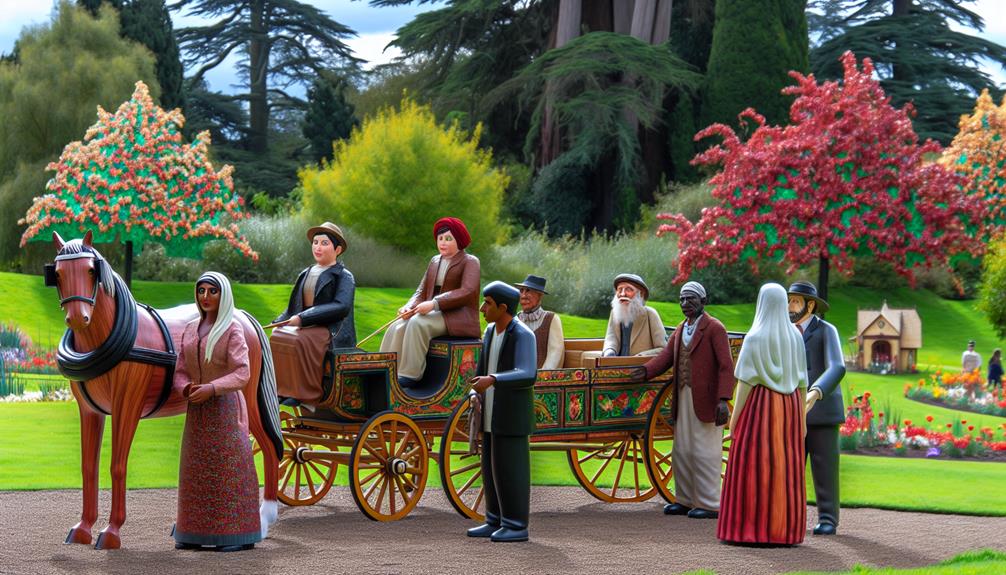
How did carriages become emblematic of societal status and cultural identity across various historical epochs? Throughout history, carriages transcended their utilitarian function, evolving into potent symbols of social symbolism and collective identity. They served not merely as modes of transport but as reflections of power, wealth, and cultural narratives, shaping the perceptions and aspirations of society.
- Status Indicator: The ornate design and craftsmanship of carriages often signified the owner's wealth and social standing.
- Cultural Identity: Different regions developed unique carriage styles, reinforcing local identities and traditions.
- Social Gatherings: Carriages facilitated social interactions, becoming central to events such as parades and weddings, thereby weaving themselves into the fabric of community life.
- Historical Narratives: Carriages have played pivotal roles in significant historical events, from royal processions to revolutionary movements, marking their place in our shared history.
These dimensions of carriages illustrate their profound impact on societal structures and personal identities. As we reflect on these historical narratives, we gain insight into how carriages fostered a sense of belonging and continuity within diverse communities, marking their significance in the tapestry of human experience.
Lasting Impact on Modern Transportation
The evolution of vehicle design can be traced back to the innovations introduced by carriages, which laid the groundwork for contemporary transportation systems. Their influence is particularly evident in the development of public transit, where the principles of accessibility and efficiency continue to guide modern transit solutions. Moreover, the cultural significance of carriages persists today, reflecting societal values and shaping the way we perceive mobility in an increasingly interconnected world.
Evolution of Vehicle Design
Throughout history, the evolution of vehicle design has fundamentally shaped the trajectory of modern transportation, reflecting advancements in technology, materials, and human needs. This progression has led to vehicles that not only serve functional purposes but also embody cultural values and aspirations. Key trends in vehicle design can be identified as essential touchpoints in understanding modernity:
- Streamlined Aerodynamics: Enhancements in design have prioritized energy efficiency, reducing drag and improving performance.
- Minimalist Aesthetics: Contemporary vehicles often embrace simplicity, focusing on clean lines and uncluttered interiors that create a sense of calm and sophistication.
- Ergonomic Considerations: Modern designs increasingly prioritize driver and passenger comfort, integrating features that support natural body positioning and ease of use.
- Sustainable Materials: The shift toward eco-friendly manufacturing has prompted the use of sustainable materials, reflecting a growing societal commitment to environmental responsibility.
These innovations—together with safety features, technological integration, luxury enhancements, and modular designs—illustrate how vehicle design not only meets practical demands but also resonates with the collective identity of communities, fostering a sense of belonging in an ever-evolving world.
Influence on Public Transit
Public transit systems have undergone significant transformations influenced by innovations in vehicle design, which have played an indispensable role in shaping urban mobility and accessibility. The legacy of carriage history is evident in contemporary public transport, where the evolution of design principles has led to increased efficiency and user experience.
The following table highlights key developments that illustrate this influence:
| Year | Innovation | Impact on Public Transport |
|---|---|---|
| 1820 | Horse-drawn omnibuses | Expanded access for urban residents |
| 1880 | Electric streetcars | Enhanced speed and reliability |
| 1900 | Motorized buses | Increased capacity and flexibility |
| 1960 | Rapid transit systems | Reduced congestion in cities |
| 2000 | Eco-friendly vehicles | Promoted sustainability in transport |
These advancements reveal how public transport has continually adapted to meet the needs of growing urban populations, while the foundational concepts of carriage design persist. Fundamentally, the integration of lessons learned from carriage history has fostered an environment where public transit is not merely a means of transportation, but an essential component of community connectivity and social inclusion.
Cultural Significance Today
Carriage culture has left an indelible mark on modern transportation, shaping not only the design and functionality of vehicles but also the broader societal perceptions of mobility. Today, the legacy of carriages resonates through various facets of our transportation systems, reinforcing cultural heritage and social symbolism.
- Design Influence: Many contemporary vehicle designs echo the elegance and aesthetics of historical carriages, promoting a sense of nostalgia and belonging.
- Public Perception: Carriages symbolize a time of grace and leisure, influencing how society views modern transportation as not just a means to an end, but as an experience.
- Sustainability: The resurgence of horse-drawn carriages in urban tourism reflects a growing appreciation for sustainable practices, linking past and present.
- Cultural Events: Many cultural ceremonies and parades continue to feature carriages, highlighting their role in community identity and social gatherings.
Frequently Asked Questions
What Materials Were Commonly Used in Carriage Construction?
Carriage construction historically employed a variety of materials, with wood types such as oak, ash, and maple being predominant for their strength and durability. These woods provided the necessary structural integrity to withstand the rigors of travel. Additionally, metal fittings, including iron and brass, were utilized to enhance stability and longevity. This combination of materials not only guaranteed functionality but also reflected the craftsmanship and aesthetic values of the time, fostering a sense of belonging to a rich tradition.
How Did Carriages Influence Fashion Trends in Their Era?
Carriages greatly influenced fashion trends by serving as a canvas for carriage aesthetics, which reflected the prevailing styles of the time. The design, color, and embellishments of carriages often mirrored contemporary fashion, reinforcing the social status of their owners. Wealthy individuals adorned their carriages with luxurious materials and intricate designs, thereby setting trends that permeated clothing and accessories. This interplay between carriage design and fashion underscored the importance of visual identity in social stratification.
Were There Notable Carriage Manufacturers in History?
Throughout history, several famous manufacturers emerged as leaders in carriage production, greatly contributing to carriage innovations. Notable companies such as Brewster & Co. and Houghton & Co. were renowned for their craftsmanship and design excellence. These manufacturers not only influenced transportation technology but also shaped societal norms, reflecting the elegance and status associated with their products. Their advancements in materials and engineering set standards that resonated with the aspirations of their contemporary clientele, fostering a sense of belonging.
What Safety Measures Were Implemented in Carriage Design?
In carriage design, safety measures were paramount, leading to the development of advanced braking systems that enhanced control and reduced accidents. These systems included features such as multiple brake types and improved lever mechanics, ensuring reliable stopping power. Additionally, passenger comfort was carefully considered, with designs that incorporated cushioning and secure seating arrangements, thereby minimizing the risk of injury during travel. Such innovations reflected a commitment to both safety and enhanced user experience in transportation.
How Did Carriages Impact Rural Transportation Differently Than Urban?
Carriages greatly influenced rural transportation by enhancing accessibility to remote areas, allowing for the movement of goods and people across expansive landscapes. In contrast, urban environments faced challenges of congestion, where carriage proliferation often exacerbated traffic issues. The adaptability of carriages in rural settings fostered economic growth, while their presence in cities necessitated the development of infrastructure to mitigate congestion. Consequently, the dual impact of carriages reflects the divergent transportation needs of rural and urban contexts.



